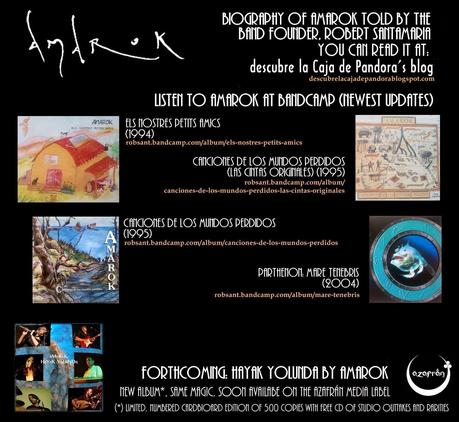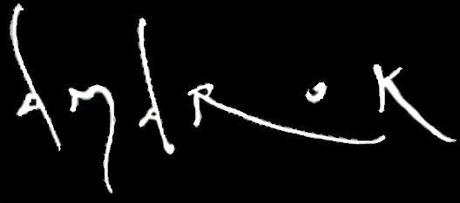 Con la formación de Amarok trabajando duramente en lo que será un nuevo disco en estudio, del que ya os daré cuenta cuando el proyecto ya esté más afianzado, os presento la historia del grupo, contada por su propio fundador, Robert Santamaría, con su versión en inglés, que espero que os resulte de provecho para acercaros a este grandísimo grupo que estrena página en Bandcamp donde degustar su exquisita música y donde se incluyem varias sorpresas que se irán aumentando conforme se vaya actualizando. Sin más preámbulos, Robert Santamaría os presenta a Amarok en esta primera parte.
Con la formación de Amarok trabajando duramente en lo que será un nuevo disco en estudio, del que ya os daré cuenta cuando el proyecto ya esté más afianzado, os presento la historia del grupo, contada por su propio fundador, Robert Santamaría, con su versión en inglés, que espero que os resulte de provecho para acercaros a este grandísimo grupo que estrena página en Bandcamp donde degustar su exquisita música y donde se incluyem varias sorpresas que se irán aumentando conforme se vaya actualizando. Sin más preámbulos, Robert Santamaría os presenta a Amarok en esta primera parte.PARTE I. DE LOS ORÍGENES A CANCIONES DE LOS MUNDOS PERDIDOS
Esta es la historia de un proyecto, de un sueño, de una obsesión, de una manera de entender la música y también la vida. También es en no poca medida mi propia historia durante 20 años. En este largo y a veces tortuoso camino han pasado y han quedado muchas cosas, he hecho un buen puñado de amigos, he vivido grandes amores y desamores, y he aprendido y desaprendido sobre muchas cuestiones. Com grupo hemos vivido éxitos inesperados, sonoros fracasos, decepciones, momentos de éxtasis, situaciones surrealistas, hilarantes, tristísimas. Risas, llantos, nervios, noches sin dormir, robos, excursiones asombrosas, fiestas, aburrimiento... Y si os parece, vamos al trapo.
PRÓLOGO
Descubrí el rock progresivo a los 13 años, y si la memoria no me falla, los primeros álbumes que escuche fueron Close to the Edge, Wish You Were Here, Brain Salad Surgery y A Passion Play. Con ellos sentí por primera vez que había vida más allá de Los Beatles, y enseguida me convertí en un insaciable buscador de discos. Compraba de los grupos que ya iba conociendo gracias a aquellos que sabían más que yo, y de los que no, tan sólo aquellos en los que en sus créditos aparecía la palabra mágica: sintetizador. Inevitablemente, con tanto empacho de Hammonds, Mellotrones y Minimoogs, me entró el gusanillo de ser teclista, y ambicionaba algún día quedar rodeado por una montaña de esos portentosos artilugios, Rick Wakeman prepárate!!!. En 1978 tuve por fin en mis manos el primero de ellos: un sintetizador Roland SH-2000, probablemente la peor opción posible para aprender a tocar un instrumento, ya que era monofónico (es decir, sólo se podía tocar UNA tecla a la vez). Pero en ese momento eso me daba exactamente igual y me dedicaba con entusiasmo a aporrear el teclado, mover los potenciómetros e intentar entender de que iban los filtros y los osciladores. Algunas tardes, me reunía con mis camaradas de instituto para hacer un poco de escándalo y grabarlo, con la extraña y supongo que injusta circunstancia de que su instrumental era un tanto más precario que mi flamante Roland: latas de galletas, sartenes, y, en el mejor de los casos, alguna armónica o flauta dulce...
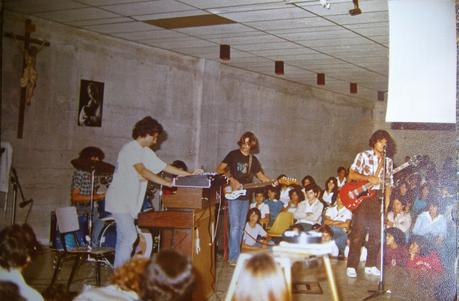
Parthenon en el Colegio Champagnat de Caracas. Junio de 1979
En esas estuvimos un año, hasta que yo por fin tuve un órgano con el cual utilizar los nueve dedos que no había usado con el Roland, y mi amigo Juan Carlos una batería de deslumbrante color azul. Inmediatamente, y junto a otros compañeros igual de raros que nosotros creamos un grupo: Parthenon. Debutamos en el instituto en junio de 1979, e interpretamos una abigarrada colección de temas propios con pretensiones emersoniano-pinkfloyanas y versiones como “Stairways to Heaven” y “Dust in the Wind”. Sonó más bien tirando a terrible (y me consta porque esa grabación existe a día de hoy!!), pero fue para todos un sueño hecho realidad. A trancas y barrancas, el grupo sobrevivió hasta 1981, habiendo llegado a unas cotas que todavía hoy en día me atrevo a catalogar como dignísimas. Como un acto de justicia y regocijo, en el año 2004 se editó el disco de Parthenon Mare Tenebris, que incluía mucho material compuesto a principios del nuevo siglo, algunas versiones de canciones originales de Parthenon e incluso tres grabaciones de la época. En el disco tocó la batería Juan Carlos, después más de 15 años de nuestro último encuentro musical más o menos serio.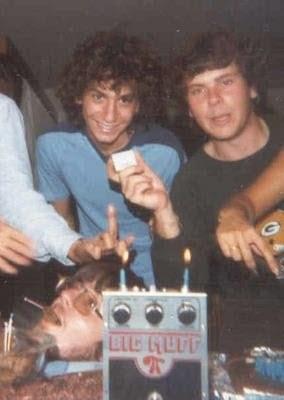
Parthenon 1980-1981
En esos primeros 80 también en Venezuela el rock progresivo estaba a punto de ser barrido del mapa por las nuevas corrientes musicales, todas ellas diametralmente opuestas a las de los años 70. Ante esa imparable avalancha, la mayoría de mis amigos músicos se fueron adaptando antes o después. Y como yo fui incapaz de hacerlo, al final me quedé más sólo que la una. Sin embargo, tuve la suerte de adquirir un vetusto magnetófono de 4 pistas, que me permitió adentrarme en el mundo de las grabaciones, a la vez que intentaba mejorar como teclista y, poco después, con la guitarra de 12 cuerdas (obviamente inspirado por el gran Anthony Phillips). En cualquier caso fueron años más bien tristones y un tanto frustrantes, en los que generé y participé en extraños e inviables proyectos (Pequeño Juan, Proyecto Ocam, Collage, Podium...) que quedaron relegados casi al 100% a las cintas magnetofónicas, y eso en el mejor de los casos.Sin embargo, a partir de 1985-86 aires nuevos soplaban en algunos reductos caraqueños, y me interesé por la música incidental (bandas sonoras o música para documentales), y lo que luego se dio por denominar new age, aunque en esos años eran simplemente un puñado de músicas diferentes al rock y los estilos tradicionales. Ellas resultaron ser una adecuada válvula de salida a mis inquietudes creativas, y músicos como Andreas Vollenweider, Mark Isham, Suso Sáiz, y el catálogo del primer Windham Hill, fueron buenas influencias en esos años. El resultado de ello fue que me dediqué a componer música de base electrónica sobre temas de la naturaleza y divulgación científica, y acompañarlos de diapositivas, que luego presentaba en público. Y en eso andaba cuando crucé el charco en el año 1987, y una vez instalado en Sabadell, me dediqué con furia un tanto obsesiva a divulgar estos audiovisuales musicalizados. “Canciones de los bosques caducifolios”, “Roraima”, “Cazadores y presas”, “Dinosaurios” fueron algunos de los que hice, junto con algunos encargos para poner música a vídeos divulgativos. Para ese entonces ya estaban en el mercado los primeros samplers, que me abrieron un asombroso océano de posibilidades sonoras.... Por esa época escuché Enya, y eso fue la tercera revelación: era posible hacer música cantada interesante que no fuera ni rock ni pop. Ello revivió mi pulsión ancestral de tener un grupo de verdad, que de momento sería un duo con una cantante. Y como el nombre del grupo lo tenía claro desde hacía algunos años, cuando ví la película Never Cry Wolf, tan sólo me quedaba encontrar a la persona adecuada. Y, cuando en algún momento de finales de 1989 Lídia entró por primera vez en el estudio, la ecuación se completó y nació Amarok.1. LOS ORIGENES: MIGRACIONS.
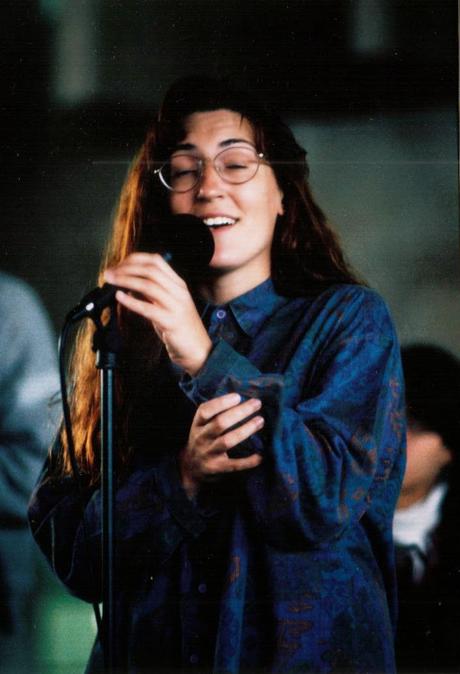
Lidia en la UAB 1991
Comenzamos a trabajar con algunos temas que ya estaban compuestos y tan sólo esperaban por la voz y las letras, aunque también mantuvimos el set de música electrónica con diapositivas. Cuando le dije a Lidia, cuya experiencia principal era la de cantar como soprano ligera en el coro de la UAB, que teníamos una fecha para mayo de 1990 en la sala barcelonesa KGB, casi le da un infarto. Sin embargo, llegado el día tocamos e incluso nos las pasamos bien, eso sí, con la ayuda del saxofonista Miquel Palomares y todo un arsenal de fotos de ilustraciones de dinosaurios, cascadas, rebecos y águilas desenfocadas, montañas nevadas....Una cosa altamente surrealista pasó por ese entonces: Mike Oldfield editó su disco Amarok. No me lo podía creer, pues pensaba que el nombre era a prueba de bombas. Leí el libreto una y otra vez para buscar alguna referencia a los lobos (Amarok quiere decir lobo en lengua inuit), pero nada. De dónde sacó el nombre entonces??? Aghhhh! Y entre la disyuntiva de cambiarle el nombre al grupo o condenarnos por siempre a que la gente pensara que lo habíamos sacado del disco, optamos por la segunda, y a apechugar malentendidos. Años después, me enteré de que el título del disco de Oldfield podía ser la contracción de la frase ‘I’m a Rock’, en referencia a sus tumultuosas relaciones con la Virgin. Vaya con las casualidades.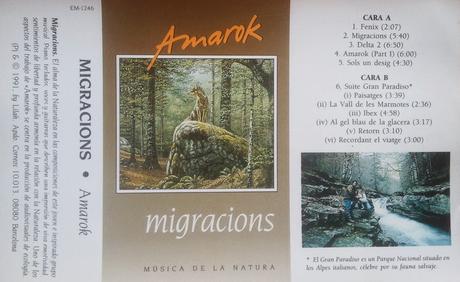
Migracions. Música de la Natura (1991)
No nos faltaban actuaciones en esos tiempos en que la new age andaba pegando fuerte, y no fue especialmente difícil lograr que en 1991 la revista Integral nos editara un cassete, Migracions. Se trató de una producción un tanto pretenciosa que tuvo que ser remendada por momentos para no hundirse estrepitosamente. Muchos músicos invitados pero poca experiencia para situarlos correctamente. Sin embargo, tenía buenos momentos y por ello funcionó razonablemente bien, tanto así que gracias al casetito fuimos a tocar a Venezuela en 1992, cosa que para mí fue sumamente especial. En esa época tocábamos en dúo o en trío con oboístas que iban y venían, y ya no dependíamos de las diapositivas, aunque las seguíamos usando de cuando en cuando. La música del cassette seguía ese formato, pues tenía una cara cantada y la otra no. Esta etapa se cerró en otoño de 1992, cuando dimos nuestro tercer concierto en años consecutivos en el Mercat de Música Viva de Vic. Fue un auténtico desastre, y además justo delante de una tropa de productores y promotores que venían a husmear grupos noveles. La torta, pues. Este tropiezo, unido a que en breve me iba a mudar al campo y estaría largos meses sin electricidad, hizo que el grupo entrara en estado de animación suspendida, sin más opción que la de reflexionar sobre cuales serían los pasos a dar en el futuro.2. RETIRADA Y REGRESO: ELS NOSTRES PETITS AMICS.
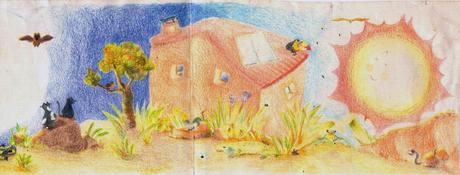
Ilustración de Lidia como idea inicial para la carátula de Els Nostres Petits Amics
Largos y fríos meses pasamos Lidia y yo acondicionando la casa y sobre todo el futuro estudio de grabación. Desde Febrero hasta Junio, cuando por fin llegó la primera placa solar, vivimos a la luz de las lámparas de gas y las velas. Y en agosto, con la instalación felizmente completada, llegó por fin hora de encender los aparatos. Es decir, un enorme magnetófono de ocho pistas que había comprado en esos meses y una mesa de mezclas (trastos ellos que en pocas horas se chupaban de las sufridas baterías lo que las placas habían tardado largas horas en cargar). Esta dependencia al límite del sol fue una constante durante muchos años, y tan sólo fue superada con la llegada del primer ordenador portátil al estudio en el año 2009, 16 años después! Otra cosa que hice en esos tiempos precarios fue retomar la guitarra de 12 cuerdas para incorporarla en el repertorio del grupo. Al menos la guitarra se podía tocar sin electricidad.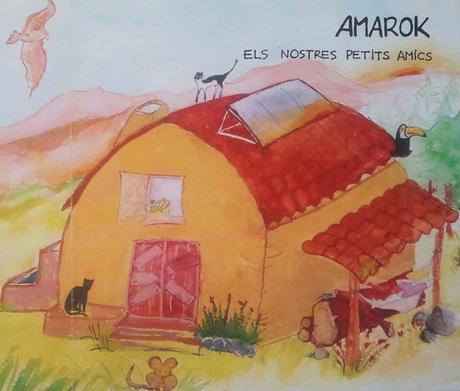
Els Nostres Petits Amics (1994)
Un día de ese verano de 1993 vinieron a mi nueva casa tres músicos muy diversos a los que nos unía una idea común: la de fundar un sello discográfico, al que llamaríamos “Bucanero Records”, porque funcionaría al margen de la legalidad. Por supuesto (y por suerte) tan insensato proyecto nunca fructificó, pero si nos permitió que dos de ellos, el estupendo percusionista y compositor Manel Sesé y el aguerrido baterista Alfredo Arcusa, pasaran en breve a formar parte activa del grupo. Todos los meses que siguieron los pasamos grabando el disco, con la ilusión de editarlo en el para nosotros novedoso formato de CD. Material revisado del cassetteMigracions, temas nuevos, buenas y bien medidas colaboraciones, y sobre todo, mucho tiempo y cariño para grabar y mezclar. Así, en primavera de 1994 vio la luz Els Nostres Petits Amics(nuestros pequeños amigos), inspirado en el título de una canción de Anthony Phillips. La carátula la hizo mi amigo del alma Ramón Bernal, inspirado en la vida de la Vinyota (mi casa) con gran protagonismo para esos pequeños amigos animales que la habitan también. Un tanto naif, quizás, pero era lo que tocaba entonces. El disco quería también ser una declaración de principios sobre el trabajo artesanal en el cada vez más tecnológico negocio de la música. Lo hicimos en una arriesgada autoedición que nos costó una fortuna, pero que por suerte en aquellos tiempos en que la gente compraba discos se autofinanció satisfactoriamente, incluyendo sorprendentes ventas allende los mares.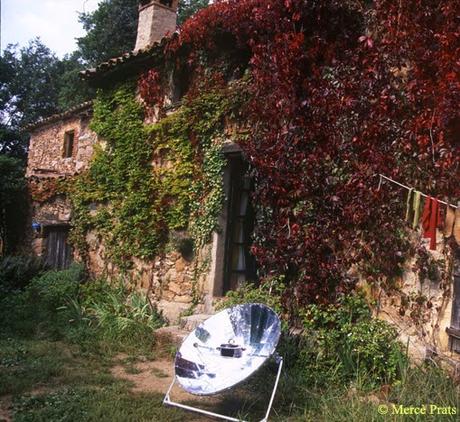
La Vinyota
En esa época no tocábamos, pero seguíamos grabábamos con entusiasmo, así que en unos cuantos meses dejamos acabado material suficiente para un segundo disco. A finales de 1994 Manel y yo nos fuimos a Madrid a buscar una discográfica, pues otra autoedición ya no entraba en nuestros planes. Entre otras varias, llamamos a las puertas del prestigioso sello Lyricon, que también apostaba por proyectos Made in Spain. Nos atendió un personaje enorme de casi dos metros de altura: Pedro Vaquero, el jefe. Ante él nos sentimos terriblemente empequeñecidos, pero casi nos convertimos partículas elementales cuando nos preguntó con su profunda voz de barítono que cuales eran nuestras razones para ir a Lyricon a intentar colocar nuestro disco. Yo balbuceé algunas palabras ponderando el interesante catálogo que manejaban, con la inquietante certeza de que mi poder de convencer a este gigante era prácticamente nulo. En un plis plas le dimos el primer CD, la maqueta en cassette del nuevo proyecto, y salimos tan raudos como pudimos, absolutamente convencidos de haber fracasado. Asombrosamente, a los 15 días me llamó el mismísimo Pedro para comunicarme con su habitual lenguaje directo y sin concesiones que le interesaría editar el disco. No sé si existen las brujas pero de que vuelan, vuelan.3. AL ESTUDIO DE GRABACIÓN: CANCIONES DE LOS MUNDOS PERDIDOS.
Así como les había gustado la música, no les gusto nada la calidad del sonido de la demo grabada con tanto mimo en nuestro estudio-cuadra de animales. La buena noticia: que iríamos a un estudio de grabación digital. Digital??? Alucinante!!! La mala: que disponíamos de una semana para hacerlo. Una semana???? Pero habíamos tardado casi un año en grabarlo en casaaaa!!! Ante tamaño reto, sólo nos quedaba planificar la producción al milímetro, llamar a los colaboradores en el momento preciso y sobre todo, invocar a los dioses para que no hubiera ni un sólo contratiempo. Metrónomos y primitivos bajos midi pregrabados para tocar encima, guitarra de 12 cuerdas, percusiones, guitarra española, oboe, violín, batería, voces, glockenspiel, puñetas....tic tac tic tac... la locura. Milagrosamente legamos al domingo por la tarde con todo correctamente grabado, pero sin ninguna mezcla. Obviamente, a la discográfica no le quedó más remedio que pagarse dos días adicionales de estudio para mezclar, al igual que se había pagado el viaje desde Alemania (cuando no existían los vuelos low cost) de nuestra inseparable oboísta Kerstin Kokocinsky, que por suerte también era altísima, tocaba como los ángeles y le cayó muy bien a Pedro!!!

Canciones de los Mundos Perdidos (1995)
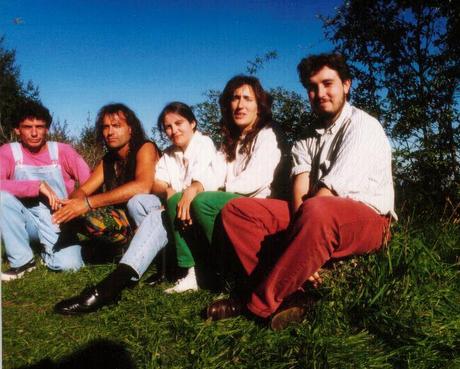
Durante la grabación de Hidrogen (1995)
Y aunque el disco no se vendió mal, no fue suficiente para cubrir las expectativas (y los gastos) que en Lyricon esperaban, y eso que hubo un momento en que los japoneses se interesaron extraordinariamente, e incluso se planteó la posibilidad de ir a tocar allá. Lástima. Con una efímera formación que duró dos conciertos, constituida por Lidia Cerón a la voz, Manel Sesé a la percusión, Asy Guerrero a la guitarra española y el bajo, Joan Morera en el violín y yo mismo en los teclados, la guitarra de doce cuerdas y el balafón, lo presentamos con éxito en la sala Otto Zutz de Barcelona y la Universidad Autónoma de Barcelona. Para el primero preparamos de nuevo un ambicioso montaje de diapositivas, que, aparte de las típicas fotografías de naturaleza, incluía ilustraciones de la polifacética Asy. Por desgracia, ambos proyectores fallaron durante del concierto, con lo que decidimos poner punto y final a la etapa de conciertos con pase de diapositivas. Mejor suerte tuvimos en la televisión, pues Albert Reguant y todo el equipo del excelente programa Hidrogensubieron (con grandes dificultades) a mi casa para filmar un estupendo programa especial.La cosa prometía...
ENGLISH VERSION FOR AMAROK BIOGRAPHY
This is the story of a project, a dream, an obsession, a way of understanding music andlife. This is also my own story for 20 years.In this long and sometimes tortuous path many things have happened: I've done a bunch of friends, I haveexperienced both great loves and hates, and I’ve learned and unlearned about a lot of issues. As a band we have experienced unexpected successes, great failures, disappointments, moments of ecstasy… surreal, hilarious, very sad situations. Laughter, tears, nerves, sleepless nights, theft, amazing trips, parties, boredom... but if you want, let’s discover the beginnings.
PROLOGUE
I discovered the progressive rock when I was 13, and if memory serves me, the first albums I heard were Close to the Edge, Wish You Were Here, Brain Salad Surgery and A Passion Play. I felt that there was life beyond The Beatles, and then I became an insatiable searcher of prog recordings. I bought those groups I had already known by other people who knew more than me. And I only bought the discs that had that magical word in their credits: synthesizer. Inevitably, with such surfeit of Hammonds, Mellotrons and Minimoogs, I got the itch to be keyboardist, and hoped to be surrounded by a mountain of these mighty gadgets someday. I told myself: ‘Get ready, Rick Wakeman!’ In 1978 I finally had the first one: a Roland SH-2000 synthesizer, maybe the worst choice to learn to play an instrument as it was monophonic (i.e. you could only play ONE key at a time). I didn’t care about it in that moment and I usedto bang the keys while moving the potentiometers. I hardly tried to understand the meaning of all those filters and oscillators. Some evenings, I met with my high school fellows to make noise and record it knowing that their instruments were somewhat poorer than my new Roland: biscuit tins, pans, one harmonica or a recorder at its best...
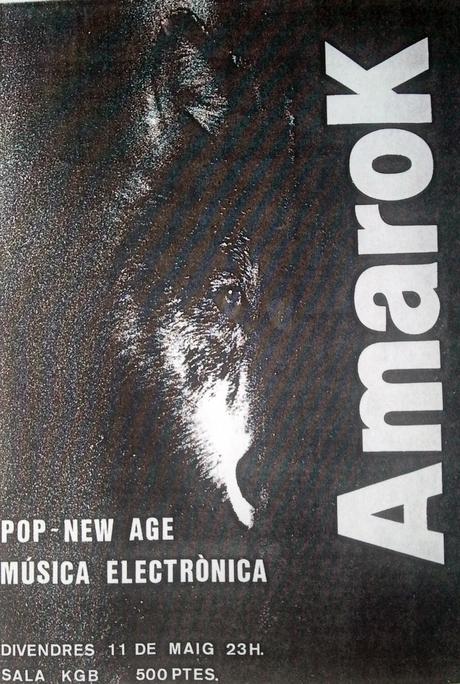
KGB venue poster
We were doing these things for a year until I finally got an organ in which I could use the nine fingers that I had not used playing the Roland. On the other hand, my friend Juan Carlos got a stunning blue drum kit. I immediately, along with other rare colleageues, created a band: Parthenon. Our first show was in June 1979 in our High School and we played our compositions in an Emersonian and Pinkfloydesque style and we also made covers such as “Stairway to heaven” or “Dust in the wind”. I haveto confess that we sounded terrible (and I know because that recording exists today!!), but it was a dream come true in the end. Up and down, the group survived until 1981, and we reached a dimension that even today I dare classify as most worthy.The Parthenon album, Mare Tenebris, was released in 2004 as an act of justice and joy. It contained a lot of stuff written early in the new century, including some versions of original songs and even three recordings of those old days. Juan Carlos, after knowing each other for 15 years, played the drums on the album.In the 80’s –I’m talking about Venezuela-, progressive rock was also about to be wiped out by the new musical trends, diametrically opposed to those of the 70’s and most of my musician friends adopted the new tendencies because of that unstoppable avalanche. I was unable to do that, so I was alonein the end.However, I was fortunate to acquire an old 4 track recorder machine which allowed me to investigate the world of recordings, while trying to improve as a keyboardist and shortly afterwards as a 12-string guitar player too (obviously inspired by the great Anthony Phillips). I participated in strange and unfeasible projects, such as Little John, Ocam Project, Collage or Podium, but in any case they were frustrating years that remained recorded only on tape… in the best of cases. However, from 1985-86 new winds were blowing in Caracas and I became interested in the so called incidental music (soundtracks or music for documentaries), and what was named new age, a handful of different music to rock and traditionalstyles in those years. They proved to be a suitable outlet to my creative interests, and musicians such as Andreas Vollenweider, Mark Isham, Suso Sáiz, or the first Windham Hill catalog were good influences in those years. Because of that I started to compose electronicmusic based on nature and popular science themes and when I played live I suported the music with slide projections.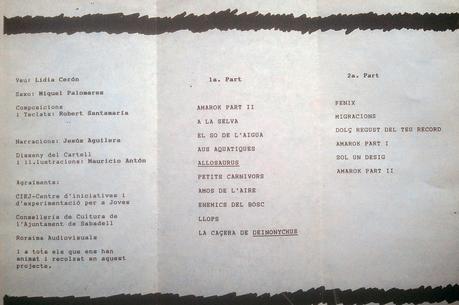
KGB inner flyer
In 1987 I crossed the pond and moved to Sabadell, Barcelona, where I began furiously to develope audiovisualstuff with music. I did some documentaries with music such as “Canciones de los bosques caducifolios”, “Roraima”, “Cazadores y presas” and “Dinosaurios”, along with many other informative videos I was requested for. In those days the early samplers appeared opening me an amazing ocean of sound possibilities.But the third revelaltion was Enya. I was listening to her and I realized that a sung music, neither rock nor pop, was possible. This revived my ancestral desire of founding a real band, a duo with a female singer in that early stage. It was clear to me the name of the group since I saw the film Never Cry Wolf and I only needed to find the right person. When I met Lidia by the end of 1989 Amarok was born.I. BEGINNINGS: MIGRACIONS
We started to work as a duo on a series of already written themes that were waiting just for a voice and some lyrics and we also maintained the electronic music set including the visual slides. When I told Lidia, who was a light soprano in the UAB chorus, we were going to play in may 1990 at KGB venue in Barcelona, she nearly had a heart attack. Nevertheless we had a very good time playing that day and we have some help from saxophonist Miquel Palomares and a huge set of photographs that showed the audience dinosaurs, waterfalls, unfocused chamois and eagles, snowy mountains… It was the time when Mike Oldfield released his album titled Amarok and I just could not believe it. I thought it was a strange name to choose and I started back to read about wolves in different books because Amarok means wolf in inuit language. I can’t see how Oldfield could choose that name yet. But we decided to go on with the Amarok name. Some years later I discovered that the Olfield album name, in trouble with the Virgin label, referred to the expression ‘I’m a rock’… nothing to do with wolves. What a coincidence!
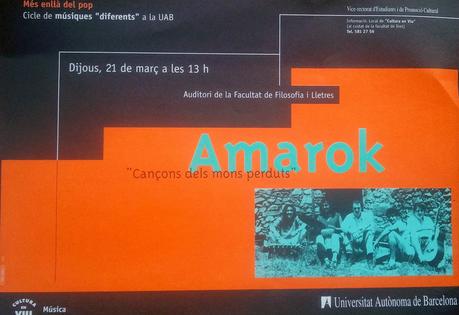
UAB concert
In those new age times we gave regular concerts and in 1991 Integral magazine released the Migracions cassette. It was a pretentious production that required arrangements to succeed. There were a lot of guest musicians but we had little experience. However, it had good musical moments and worked reasonably well. For this reason we could play in Venezuela in 1992. It was really great for me.We were playing as a duo or as a trio, with oboists coming and going, and we didn’t depend on slides though we still using them from time to time. The cassette had one sung side but the other was just instrumental.This first stage ended in the autumn of 1992, just when we performed our third show in the Mercat de Música Viva in Vic. It was an absolute disaster in front of a lot of producers and promoters that were searching for new bands. It was quite a shock. Add to all this that I was going to move to the countryside and I was going to be several months without power. The band was going to be in a suspended animation state and I should consider the steps to be taken in the future.II. WITHDRAWAL AND RETURN: ELS NOSTRES PETITS AMICS
Lídia and I lived long and cold months while building our home and our future recording studio. From February to June, when we had our first solar panel, we had light through gas lamps and candles. In August we finally could turn on the appliances. That is, a huge eight track tape recorder I had bought the months before and a mixer (that in a few hours depleted the batteries after long hours loading). We depended on the sun constantly and this happened for many years. Our first laptop in our study in 2009 was a big step though it happened 16 years later. Another thing I did in these precarious times was to retake the 12-string guitar in order to incorporate it into the group’s repertoire. I could play the guitar without electricity at least.
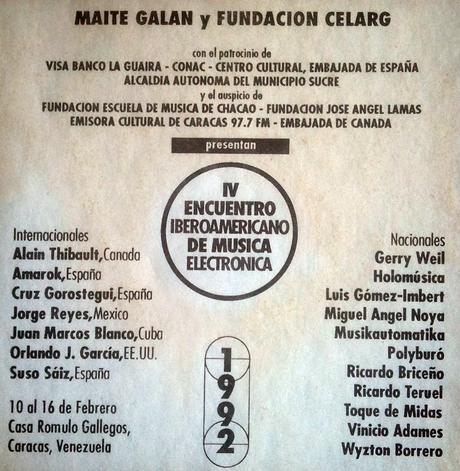
Venezuela 1992
One day in the summer of 1993 three very different musicians came to my new house and we had a common idea: we wanted to found a record label and we called it Bucanero Records (Buccaneer Records), not a very legal label by the way. Thankfully that foolish project never came to fruition, of course, but it provided me two musicians. On one hand Manel Sesé, a great percussionist and composer, and Alfredo Arcusa, a seasoned drummer, that took part of the group for a short time. We spent the following months recording the album with the intention of an edition in the new format those days: the CD. It consisted of revisited stuff from the Migracions cassette, as well as new compositions, a lot of collaborations and, above all, lots of time and love to record and mix the product. So, in spring 1994 we released Els Nostres Petits Amics (Our Little Friends, in Catalan language) inspired by an Anthony Phillips song. The cover was painted by my soul mate Ramón Bernal, and was inspired by my lifestyle in Vinyota (my house) featuring all those little animal friends that live with me. I guess it was a little naïf, maybe, but it was what prevailed then. The recording would also be a declaration of principles about handicraft work in an increasingly technological musical business. We published a risky and expensive auto edition but it succeeded mainly from across the seas. We didn’t played live those days but we were recording enthusiastically and few months before we had written stuff enough for a sophomore recording. By the end of 1994 Manel and I went to Madrid searching for a record label because we didn’t wanted to edit any recording by our means. We came in touch, among others, with Lyricon, a prestigious label that supported made in Spain projects. We knew a tall person, Pedro Vaquero, known as the boss. We felt very small in front of him but we grew even smaller when he asked us, with a baritone voice, why we wanted to release our music through Lyricon. I hardly babbled about their interesting catalogue and we gave him our first CD, the demo cassete of our new project and we left convinced that we had failed. Amazingly, in fifteen days Pedro called me to tell me that he wanted to publish our recording. I don’t know if witches exist, but they fly.III. RECORDING STUDIO: CANCIONES DE LOS MUNDOS PERDIDOS (SONGS FROM LOST WORLDS)
They liked the music very much but the demo sound quality didn’t convince the label so they proposed to go to a digital recording studio. What the hell? Digital? Mind blowing! But on the other hand we only had one week to do it. One week? We took almost a year to record it in my own home studio. We had to plan it in detail, call all collaborators and, among all, invoke all gods not to have a setback. Metronomes and primitive MIDI bass sounds pre-recorded to overdub, 12-string guitars, percussions, Spanish guitar, oboe, violin, drums, voices, glockenspiel… what a hell!... tic toc tic toc… A madness!! We entered the studio on Sunday evening with our recorded music but without mixing. Obviously, the label had to hire the recording studio two days more in order to have the mix and they also had to pay the flight tickets to our German oboist, Kerstin Kokocinsky (no low cost these days).We finally ended the album and it was released in Spring 1995 under the Canciones de los Mundos Perdidos title. It was a kind of desired journey through imaginary worlds we loved to live. All the drawings were made by Asy Guerrero, our guitarist, and were presented as a big fold out format similar to a LP size. The title was inspired by a Tolkien story (we even dedicated a song to him), but it was a little too much like the Mike Oldfield’s Songs from the Distant Earth album he released at the same time. It seemed we lived under the shadow of Mike Oldfield.
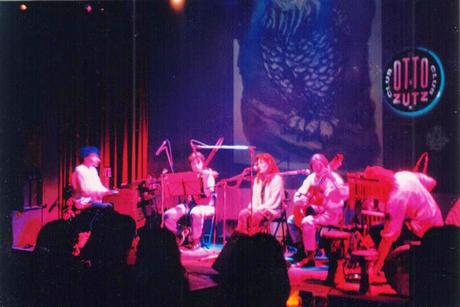
Otto Zutz venue concert (1995)
Canciones was richer, both rhythmic and musically, than our previous album. It had new age themes, 12-string symphonic rock songs (including two previous compositions from my Venezuelan times) and songs based on piano that defined our future group intentions. We didn’t enjoy the final result as it had a lower over finished quality. Nothing to do with our pastoral home recordings but we had to look forward. Fortunately, my Guardian Angel, Juan José Salas and his Mexican label Luna Negra released the original version of the album in 2010, incorporating substantial improvements, overdubbing arrangements to the original stereo tracks and adding plentiful and tasty bonus themes. I even sing in one of them, a good example of the fine treatment from Juanjo.And although the album did not sell bad, it was not enough to meet expectations (and costs) in Lyricon, though in Japan were very interested to see us play live. What a pity!With an ephemeral line-up consisting in Lídia Cerón, voice, Manel Sesé, percussion, Asy Guerrero, Spanish guitar and bass, Joan Morera, violin, and myself on keys, twelve string guitar and balafón we presented our album in the Otto Zutz venue from Barcelona and at Universidad Autónoma de Barcelona. In our first concert we displayed a slide show, consisting on nature pics and Asy’s illustrations. Unfortunately, the projector didn’t work and it was our last slide show. We were more successful on TV, since Albert Reguant and the excellent ‘Hydrogen’ team recorded a TV special in my house.The deal promised…
(To be continued)
